2104数学建模美赛A 交通流 安全性 参考资料 交通量
数学建模报告路口车况分析
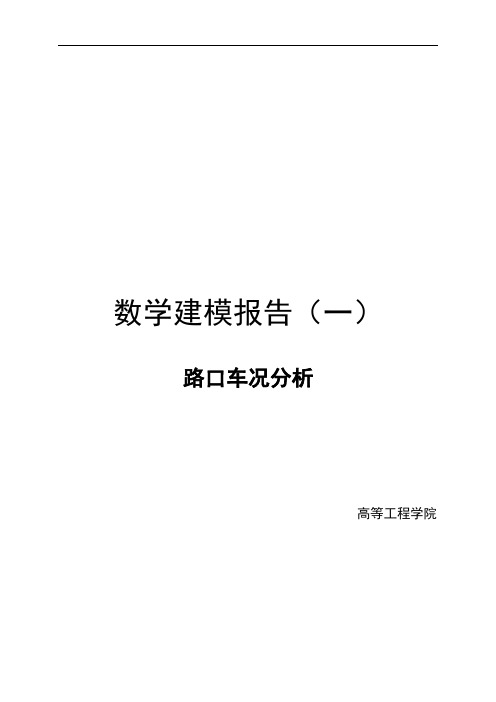
数学建模报告(一)路口车况分析高等工程学院一、路况信息我们在实验前为保证最终结果的客观性与代表性,综合分析了五道口附近各路口的Google Earth卫星地图与Baidu Map提供的实时车流预测信息,并最终选取城府路与学院路交叉十字路口(地理坐标39.99°N,116.35°E卫星照片见Figure 1)完成本次实地测量。
此路口北向车流较为密集,但几乎没有拥堵状况发生,且公交车等大型车数量较少。
南北向路段红灯时(时长60s),北向路段由西至东最内车道等待车数保持在15辆左右。
良好的路况与较大的样本量有利于我们检验教材模型参量取值的正确性,同时也有利于我们根据路口的实际车流情况,对原有模型进行完善。
Figure 1二、原始数据记录与处理我们的实验时间选定在2012年3月10日上午9:00-10:00。
具体测量内容如下:1. 北向路段,最内侧车道,绿灯亮至10s、20s、30s、60s时,通过停车线的汽车数量;2. 北向路段,最内侧车道,红灯区间的车辆间距;3. 北向路段,最内侧车道,停车线内第一辆汽车的启动延时时间,与其跑过位移S 所用时间(见Figure 2)。
关于数据采集的前期设计请参阅本文第五部分。
SFigure 22.1通过车次记录与数据波动分析我们测量了18次绿灯区间,当绿灯亮至10s、20s、30s、60s时汽车通过停车线的数量,具体数据列表如下:1 4812172 4713183 61219224 51014175 389126 4915207 4915198 41117269 410131810 49151611 37101912 410132113 510121514 59141915 48132116 59141517 371319Average 4.229.1713.6718.39数据波动分析如下图:Figure 3在实际观察中,我们发现,在每次红灯区间,停车排队等候的车辆数目稳定在12~15辆左右,且绿灯亮后前30s内通过的车辆,基本为之前停车排队等候的车辆。
数学建模--交通问题
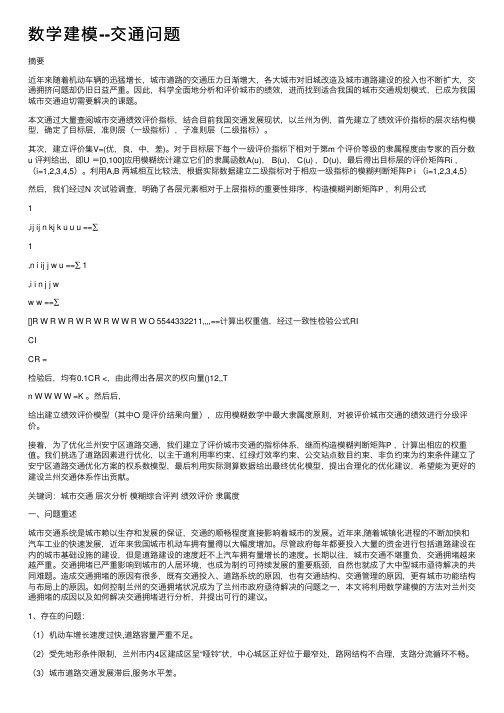
数学建模--交通问题摘要近年来随着机动车辆的迅猛增长,城市道路的交通压⼒⽇渐增⼤,各⼤城市对旧城改造及城市道路建设的投⼊也不断扩⼤,交通拥挤问题却仍旧⽇益严重。
因此,科学全⾯地分析和评价城市的绩效,进⽽找到适合我国的城市交通规划模式,已成为我国城市交通迫切需要解决的课题。
本⽂通过⼤量查阅城市交通绩效评价指标,结合⽬前我国交通发展现状,以兰州为例,⾸先建⽴了绩效评价指标的层次结构模型,确定了⽬标层,准则层(⼀级指标),⼦准则层(⼆级指标)。
其次,建⽴评价集V=(优,良,中,差)。
对于⽬标层下每个⼀级评价指标下相对于第m 个评价等级的⾪属程度由专家的百分数u 评判给出,即U =[0,100]应⽤模糊统计建⽴它们的⾪属函数A(u), B(u), C(u) ,D(u),最后得出⽬标层的评价矩阵Ri ,(i=1,2,3,4,5)。
利⽤A,B 两城相互⽐较法,根据实际数据建⽴⼆级指标对于相应⼀级指标的模糊判断矩阵P i (i=1,2,3,4,5)然后,我们经过N 次试验调查,明确了各层元素相对于上层指标的重要性排序,构造模糊判断矩阵P ,利⽤公式1,ij ij n kj k u u u ==∑1,n i ij j w u ==∑ 1,i i n j j ww w ==∑[]R W R W R W R W R W W R W O 5544332211,,,,==计算出权重值,经过⼀致性检验公式RICICR =检验后,均有0.1CR <,由此得出各层次的权向量()12,,Tn W W W W =K 。
然后后,给出建⽴绩效评价模型(其中O 是评价结果向量),应⽤模糊数学中最⼤⾪属度原则,对被评价城市交通的绩效进⾏分级评价。
接着,为了优化兰州安宁区道路交通,我们建⽴了评价城市交通的指标体系,继⽽构造模糊判断矩阵P ,计算出相应的权重值。
我们挑选了道路因素进⾏优化,以主⼲道利⽤率约束、红绿灯效率约束、公交站点数⽬约束、⾮负约束为约束条件建⽴了安宁区道路交通优化⽅案的权系数模型,最后利⽤实际测算数据给出最终优化模型,提出合理化的优化建议,希望能为更好的建设兰州交通体系作出贡献。
全国数学建模2021a题
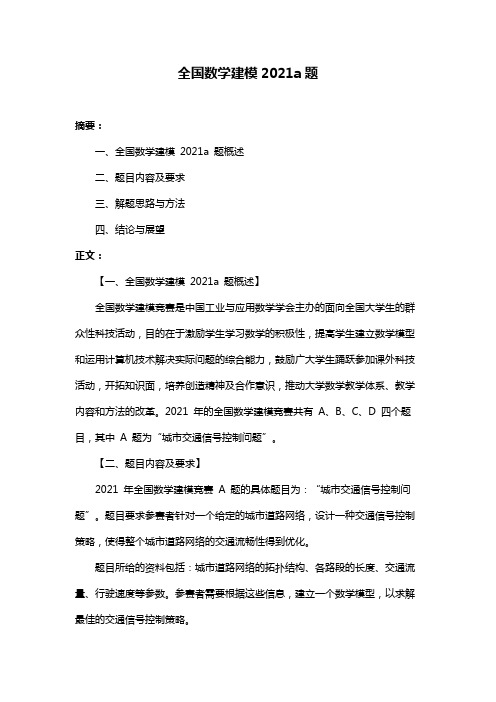
全国数学建模2021a题摘要:一、全国数学建模2021a 题概述二、题目内容及要求三、解题思路与方法四、结论与展望正文:【一、全国数学建模2021a 题概述】全国数学建模竞赛是中国工业与应用数学学会主办的面向全国大学生的群众性科技活动,目的在于激励学生学习数学的积极性,提高学生建立数学模型和运用计算机技术解决实际问题的综合能力,鼓励广大学生踊跃参加课外科技活动,开拓知识面,培养创造精神及合作意识,推动大学数学教学体系、教学内容和方法的改革。
2021 年的全国数学建模竞赛共有A、B、C、D 四个题目,其中A 题为“城市交通信号控制问题”。
【二、题目内容及要求】2021 年全国数学建模竞赛A 题的具体题目为:“城市交通信号控制问题”。
题目要求参赛者针对一个给定的城市道路网络,设计一种交通信号控制策略,使得整个城市道路网络的交通流畅性得到优化。
题目所给的资料包括:城市道路网络的拓扑结构、各路段的长度、交通流量、行驶速度等参数。
参赛者需要根据这些信息,建立一个数学模型,以求解最佳的交通信号控制策略。
【三、解题思路与方法】针对这道题目,我们可以采用以下步骤进行解题:1.首先,根据题目所给的信息,对城市道路网络进行分析,建立道路网络的拓扑结构模型。
2.其次,根据交通流量、行驶速度等参数,建立交通流的动力学模型,描述交通流在各路段上的变化规律。
3.接着,利用图论中的最短路径理论,求解交通流在道路网络中的最短路径,从而确定交通流的传播方向。
4.最后,根据交通流的传播方向和交通流的变化规律,设计交通信号控制策略,使得整个城市道路网络的交通流畅性得到优化。
【四、结论与展望】通过以上步骤,我们可以得出一套针对给定城市道路网络的交通信号控制策略。
该策略能够有效优化城市道路网络的交通流畅性,提高道路通行效率,降低交通拥堵程度。
然而,需要注意的是,由于城市交通信号控制问题具有较强的实时性和动态性,因此,本题的解决方案需要结合实际交通情况进行不断调整和优化。
数学建模在交通流量分析中的应用
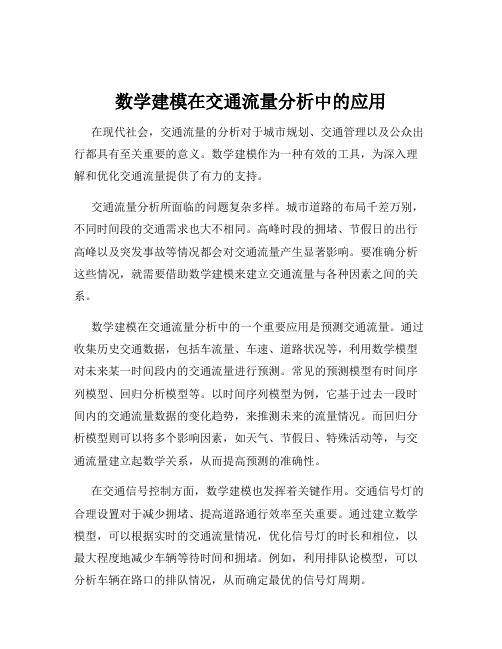
数学建模在交通流量分析中的应用在现代社会,交通流量的分析对于城市规划、交通管理以及公众出行都具有至关重要的意义。
数学建模作为一种有效的工具,为深入理解和优化交通流量提供了有力的支持。
交通流量分析所面临的问题复杂多样。
城市道路的布局千差万别,不同时间段的交通需求也大不相同。
高峰时段的拥堵、节假日的出行高峰以及突发事故等情况都会对交通流量产生显著影响。
要准确分析这些情况,就需要借助数学建模来建立交通流量与各种因素之间的关系。
数学建模在交通流量分析中的一个重要应用是预测交通流量。
通过收集历史交通数据,包括车流量、车速、道路状况等,利用数学模型对未来某一时间段内的交通流量进行预测。
常见的预测模型有时间序列模型、回归分析模型等。
以时间序列模型为例,它基于过去一段时间内的交通流量数据的变化趋势,来推测未来的流量情况。
而回归分析模型则可以将多个影响因素,如天气、节假日、特殊活动等,与交通流量建立起数学关系,从而提高预测的准确性。
在交通信号控制方面,数学建模也发挥着关键作用。
交通信号灯的合理设置对于减少拥堵、提高道路通行效率至关重要。
通过建立数学模型,可以根据实时的交通流量情况,优化信号灯的时长和相位,以最大程度地减少车辆等待时间和拥堵。
例如,利用排队论模型,可以分析车辆在路口的排队情况,从而确定最优的信号灯周期。
数学建模还能够用于评估交通规划方案的效果。
当城市规划新的道路、桥梁或者交通枢纽时,可以通过建立交通流模型来模拟不同方案下的交通流量分布。
这有助于比较不同方案的优劣,选择最能满足交通需求、提高交通效率的规划方案。
比如,在规划一个新的商业区时,可以通过建模预测未来的交通流量增长,从而提前规划相应的交通设施。
在分析交通事故对交通流量的影响时,数学建模同样不可或缺。
事故发生后,道路通行能力下降,车辆排队长度增加。
通过建立事故影响模型,可以估计事故造成的拥堵范围和持续时间,为交通管理部门采取及时有效的疏导措施提供依据。
全美数学建模大赛A论文-环岛城市交通

摘 要一、本文主要有三个数学模型:1. 通过环岛的理想模型,分析推出计算环岛的最大交通能力;对比设置停让交通标志控制以及信号灯控制对环岛通行能力。
得出:当经过环岛的实际流量'Q <环岛的最大通行能力Z Q ,应用指示牌控制法较宜,做法是在交通环岛的各个进口处设置指示牌,并设置环岛内交通车流的方向指示牌。
当'Z Q Q ≥时,宜采用信号灯控制法,并采用指示牌控制法予以辅助。
信号控制的目的在于最大限度地提高交叉口的使用效率。
2. 引入精英蚂蚁寻优策略模型。
针对城市道路交叉口的交通流特性,对单路口交通信号多相位实时控制的模型和算法进行研究。
采用能随交通需求的变化而实时变化的加权系数,将交叉口3 个优化目标函数转化为单目标函数优化的问题。
为提高模型的计算速度以及降低交叉口信号机的单机计算量,采用蚂蚁算法中的精英蚂蚁寻优3. 策略求解模型。
模型的目标方程为:ﻩ 42421411(1(/))min (,)2(1.0)[(1.0/)]/[2(1.0)](2(/))1.1(1.0)0.9(1.0/)/(1.0)2(3600/)(/)i i i i i i i i i i i i i i i Zl c Z x c s y Y c x c y l c s y Y c x c y c Y x c s Q ===-=⋅-⋅-⋅-++⋅⋅-⋅⋅⋅---⋅⋅⋅+∑∑∑4. 基于精英蚂蚁寻优策略模型,对其进行优化得到理想状态下计算信号灯系统中各路口的绿灯时间的目标方程z max (,)[2(3600/)(/)]Q i i Z x c c Y x c s =⋅⋅⋅+∑,引入算例,将算例所提供的数据代入优化得到的模型,使用软件求解。
当通过交通工程师通过观察法得到平稳期、高峰期的Y,S,当预设C 值,即可通过上述计算方法获得最大的通行量的四个信号的绿灯时长配置。
该优化模型可以将其应用到交通环岛各路口红绿灯时长的控制,并用交通标志配合控制交通流量。
2014美国数学建模竞赛赛题翻译

问题A:右行左超规则在美国、中国和大多数除了英国、澳大利亚和一些前英国殖民地的国家,多车道高速公路常常有这样一种规则。
司机必须尽量在最右的车道行使,只有超车时,司机才可以向左移动一个车道来达成目的。
当司机超车完毕后必须回到原车道继续行使。
建立并分析一个数学模型,使得这个模型能够分析这个规则在交通高负荷和低负荷情况下的表现。
你可以从许多角度来思考这个问题,比如车流量和车辆安全之间的权衡,或者一个过快或过慢的车辆限速带来的影响等等。
这个规则可以使我们获得更好的交通流?如果不可以,请提出并分析一个替代方案使得交通流得到优化、安全得到保障、或者其他你认为重要的因素得到实现。
在靠左行使才是规则的国家,论证你的解决方案是否可以通过简单的变换或者通过增加一些新的要求来解决相同的问题。
最后,以上的规则的实行是建立在人们遵守它的基础上的,然而不是所有人都愿意去遵守。
那么现在我们使同一条道(可以只是一段,也可以是全段公路)上的交通车辆都在一个智能系统的严格控制下,这个变化对你之前的分析结果有多大的影响?问题B:体育画刊是一个为体育爱好者们设计的杂志。
这个杂志正在寻找上世纪女性或者男性的“历来最优秀的大学教练”。
建立一个数学模型,从男性或者女性体育教练中选择最好的大学教练(退役或者在役的都可以)。
这些体育教练可以是大学曲棍球、陆上曲棍球、足球、橄榄球、棒球、排球、篮球的教练。
你选择划分的时间会对你的分析有影响吗?也就是说,1913年的教练方式和2013年的会有什么不同吗?清楚的阐述你的评估方式。
讨论你的模型如何通用于两性教练和所有可能的运动项目上。
用你的模型为三项体育项目分别找到五个最佳教练。
再为体育画刊提供一篇1-2页的不涉及技术性问题解释的通俗易懂的文章来解释你们的结果,你们必须保证体育爱好者们能够理解。
2014美赛A题讲解

2021/3/7
CHENLI
10
用CA模型描述交通流,主要是通过对驾驶员驾车行为的 分析,建立驾驶员或车辆的行为输出规则,从而建立元胞 自动机的运行规则,然后仿真实际交通背景,模拟整体元 胞群的动态过程,从中得到解决交通问题的方法或信息。 这类模型考虑的主要问题包括:如何用微观规则的建模来 描述元胞的运动过程;如何用宏观规则的建模来描述高速 公路运行车辆的随机性,这是交通现象的重要特征。
2021/3/7
CHENLI
13
2)平均车速( v ):
在固定路段内不同车道上所有车辆的平均时速的平均值,
过程中提取;其次,建立高速公路上车辆的运行状态随时间
变化的微观规则模型,特别是“右行左超车”的规则模型;
第三是运行车辆的不同运行状态改变的宏观概率分布,这是
由交通问题的随机性决定的, 而随机性是交通问题的一个特
别重要的特性;最后是设计元胞自动机的仿真对比试验,特
2别021/是3/7元胞群空间、初始元胞群CH密ENL度I 、分布与状态等。
2014美赛A题建模与求解
讲解人:王永丽
2014年8月11日
2021/3/7
CHENLI
1
提纲
问题描述 求解方案
1、问题分析与模型建立 2、模型求解与计算机仿真
模型优缺点分析与改进
2021/3/7
CHENLI
2
问题描述
题目:除非超车否则靠右行驶的交通规则
问题:在一些汽车靠右行驶的国家(比如美国,中国等),
2021/3/7
CHENLI
数学建模在交通流量中的应用
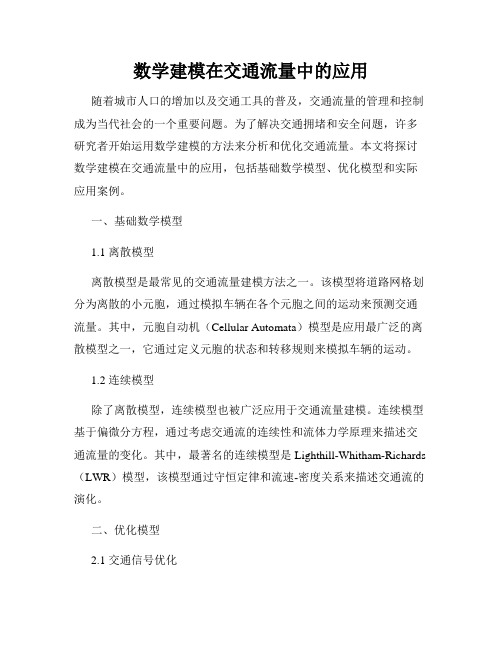
数学建模在交通流量中的应用随着城市人口的增加以及交通工具的普及,交通流量的管理和控制成为当代社会的一个重要问题。
为了解决交通拥堵和安全问题,许多研究者开始运用数学建模的方法来分析和优化交通流量。
本文将探讨数学建模在交通流量中的应用,包括基础数学模型、优化模型和实际应用案例。
一、基础数学模型1.1 离散模型离散模型是最常见的交通流量建模方法之一。
该模型将道路网格划分为离散的小元胞,通过模拟车辆在各个元胞之间的运动来预测交通流量。
其中,元胞自动机(Cellular Automata)模型是应用最广泛的离散模型之一,它通过定义元胞的状态和转移规则来模拟车辆的运动。
1.2 连续模型除了离散模型,连续模型也被广泛应用于交通流量建模。
连续模型基于偏微分方程,通过考虑交通流的连续性和流体力学原理来描述交通流量的变化。
其中,最著名的连续模型是Lighthill-Whitham-Richards (LWR)模型,该模型通过守恒定律和流速-密度关系来描述交通流的演化。
二、优化模型2.1 交通信号优化交通信号优化是交通流量管理的重要方面之一。
数学建模可以帮助确定最佳的信号配时方案,以最大程度地减少车辆的停顿和排队时间。
优化模型通常考虑交通状况、道路容量和信号周期等因素,并利用数学算法来寻找最佳解。
2.2 路网设计优化路网设计是指在给定的地理环境和交通需求下,确定最佳的道路布局和连接方式。
数学建模可以通过考虑交通流量分配、路段容量和成本等因素,来优化路网设计。
常用的优化方法包括线性规划、整数规划和遗传算法等。
三、实际应用案例3.1 城市交通拥堵预测数学建模可以根据历史交通流量数据、天气信息和事件影响等因素,来预测城市交通的拥堵情况。
通过建立拥堵预测模型,交通管理部门可以提前采取措施,减轻拥堵状况并优化交通流量。
3.2 交通事故预测与分析数学建模也可以帮助预测和分析交通事故的发生概率和影响因素。
通过建立统计模型和机器学习算法,研究者可以识别出导致事故的关键因素,并提出相应的安全措施。
全国大学生数学建模竞赛A题车辆排队长与事故持续时间道路实际通行能力路段上流流量间的关系
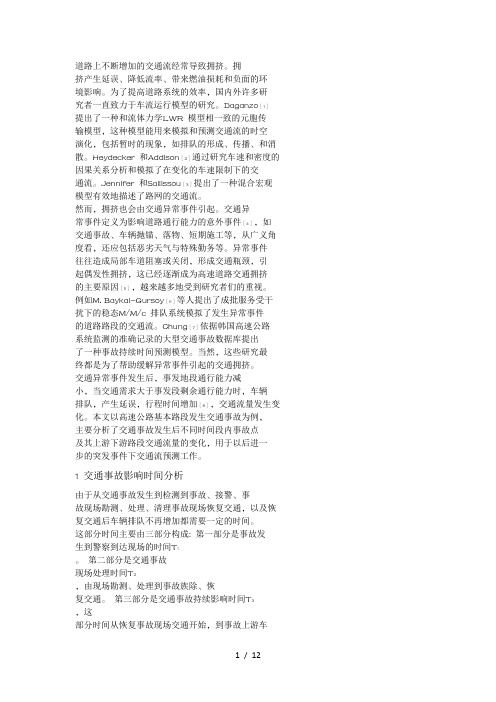
道路上不断增加的交通流经常导致拥挤。
拥挤产生延误、降低流率、带来燃油损耗和负面的环境影响。
为了提高道路系统的效率,国内外许多研究者一直致力于车流运行模型的研究。
Daganzo[1]提出了一种和流体力学LWR 模型相一致的元胞传输模型,这种模型能用来模拟和预测交通流的时空演化,包括暂时的现象,如排队的形成、传播、和消散。
Heydecker 和Addison[2]通过研究车速和密度的因果关系分析和模拟了在变化的车速限制下的交通流。
Jennifer 和Sallissou[3]提出了一种混合宏观模型有效地描述了路网的交通流。
然而,拥挤也会由交通异常事件引起。
交通异常事件定义为影响道路通行能力的意外事件[4],如交通事故、车辆抛锚、落物、短期施工等,从广义角度看,还应包括恶劣天气与特殊勤务等。
异常事件往往造成局部车道阻塞或关闭,形成交通瓶颈,引起偶发性拥挤,这已经逐渐成为高速道路交通拥挤的主要原因[5],越来越多地受到研究者们的重视。
例如M. Baykal-Gursoy[6]等人提出了成批服务受干扰下的稳态M/M/c 排队系统模拟了发生异常事件的道路路段的交通流。
Chung[7]依据韩国高速公路系统监测的准确记录的大型交通事故数据库提出了一种事故持续时间预测模型。
当然,这些研究最终都是为了帮助缓解异常事件引起的交通拥挤。
交通异常事件发生后,事发地段通行能力减小,当交通需求大于事发段剩余通行能力时,车辆排队,产生延误,行程时间增加[8],交通流量发生变化。
本文以高速公路基本路段发生交通事故为例,主要分析了交通事故发生后不同时间段内事故点及其上游下游路段交通流量的变化,用于以后进一步的突发事件下交通流预测工作。
1 交通事故影响时间分析由于从交通事故发生到检测到事故、接警、事故现场勘测、处理、清理事故现场恢复交通,以及恢复交通后车辆排队不再增加都需要一定的时间。
这部分时间主要由三部分构成: 第一部分是事故发生到警察到达现场的时间T1。
2014年美国大学生数学建模竞赛A题论文综述
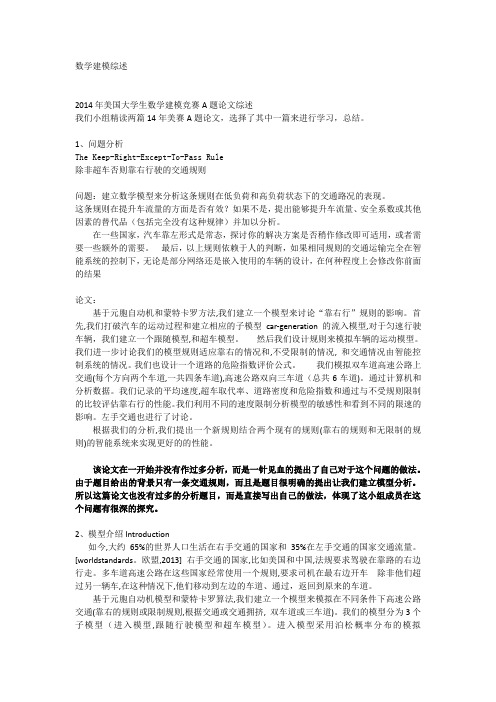
数学建模综述2014年美国大学生数学建模竞赛A题论文综述我们小组精读两篇14年美赛A题论文,选择了其中一篇来进行学习,总结。
1、问题分析The Keep-Right-Except-To-Pass Rule除非超车否则靠右行驶的交通规则问题:建立数学模型来分析这条规则在低负荷和高负荷状态下的交通路况的表现。
这条规则在提升车流量的方面是否有效?如果不是,提出能够提升车流量、安全系数或其他因素的替代品(包括完全没有这种规律)并加以分析。
在一些国家,汽车靠左形式是常态,探讨你的解决方案是否稍作修改即可适用,或者需要一些额外的需要。
最后,以上规则依赖于人的判断,如果相同规则的交通运输完全在智能系统的控制下,无论是部分网络还是嵌入使用的车辆的设计,在何种程度上会修改你前面的结果论文:基于元胞自动机和蒙特卡罗方法,我们建立一个模型来讨论“靠右行”规则的影响。
首先,我们打破汽车的运动过程和建立相应的子模型car-generation的流入模型,对于匀速行驶车辆,我们建立一个跟随模型,和超车模型。
然后我们设计规则来模拟车辆的运动模型。
我们进一步讨论我们的模型规则适应靠右的情况和,不受限制的情况, 和交通情况由智能控制系统的情况。
我们也设计一个道路的危险指数评价公式。
我们模拟双车道高速公路上交通(每个方向两个车道,一共四条车道),高速公路双向三车道(总共6车道)。
通过计算机和分析数据。
我们记录的平均速度,超车取代率、道路密度和危险指数和通过与不受规则限制的比较评估靠右行的性能。
我们利用不同的速度限制分析模型的敏感性和看到不同的限速的影响。
左手交通也进行了讨论。
根据我们的分析,我们提出一个新规则结合两个现有的规则(靠右的规则和无限制的规则)的智能系统来实现更好的的性能。
该论文在一开始并没有作过多分析,而是一针见血的提出了自己对于这个问题的做法。
由于题目给出的背景只有一条交通规则,而且是题目很明确的提出让我们建立模型分析。
数学建模在交通流量优化中的应用

数学建模在交通流量优化中的应用随着城市交通压力的不断增加,如何优化交通流量成为了城市管理者和交通专家的重要任务。
在这个问题上,数学建模发挥了重要的作用。
本文将探讨数学建模在交通流量优化中的应用,通过建立数学模型来解决交通流量优化问题,提高交通效率,减少交通拥堵。
一、道路网络拓扑模型在交通流量优化中,首先需要建立道路网络拓扑模型。
这个模型可以用来描述城市中各个路段的关联关系及其对交通流量的影响。
通过分析路段之间的连接关系,我们可以确定交通流的传播路径,并找到优化路线以减少拥堵。
在道路网络拓扑模型中,我们可以使用图论的方法进行描述。
将交通网络视为一张有向图,每个节点表示一个路口,每条有向边表示一条道路。
通过对网络中的节点和边进行建模,并引入相关的约束条件,我们可以得到一个准确的道路网络拓扑模型。
二、交通流量模型建立了道路网络拓扑模型后,接下来需要建立交通流量模型。
交通流量模型可以用来表示在不同时间段内通过道路网络的车辆数量以及其运行状态。
通过对交通流量的建模分析,可以帮助我们了解交通状况,找到瓶颈路段,并提出优化方案。
在交通流量模型中,我们可以使用微观模型或宏观模型来描述车辆的运行。
微观模型可以考虑车辆之间的相互作用,结合领车模型、车队模型等,以模拟车辆的运行轨迹和交通行为。
宏观模型则更注重整体的交通流分布、平均速度等参数的分析,以描述整个交通网络的总体状况。
三、优化算法通过建立道路网络拓扑模型和交通流量模型,我们可以得到一个具体的交通流量数据。
然而,如何根据这些数据来优化交通流量成为了另一个问题。
在这个问题上,数学建模能够提供一些有效的优化算法。
在交通流量优化中,常用的优化算法包括遗传算法、粒子群算法、模拟退火算法等。
这些算法可以通过对交通流量数据进行分析和计算,找到最优的交通路线,调整信号灯周期,优化车辆调度等,以减少交通拥堵,提高交通效率。
四、实例分析为了更好地理解数学建模在交通流量优化中的应用,我们以某城市的交通流量优化为例进行分析。
2024数学建模美赛a题

2024数学建模美赛a题
2024年数学建模美赛A题是一个假设的问题,因为目前我无法
获取未来的比赛题目。
但是,我可以向你介绍一般数学建模比赛的
题目类型和解题思路。
数学建模比赛通常会给出一个现实生活中的
问题,要求参赛者利用数学建模的方法进行分析和解决。
这类比赛
的题目可能涉及到数学、统计学、计算机科学等多个领域的知识。
一般来说,解决数学建模比赛的题目需要以下几个步骤:
1. 理解问题,仔细阅读题目,确保对问题的要求和限制有清晰
的理解。
2. 建立模型,根据问题的特点和要求,选择合适的数学模型,
可能涉及到微积分、线性代数、概率论等数学知识。
3. 数据分析,如果题目提供了相关数据,需要进行数据的整理、分析和处理,以便后续建模和求解。
4. 求解问题,利用建立的数学模型,进行求解和分析,得出结
论并进行验证。
5. 结果呈现,将解题过程、结果和结论进行清晰的呈现,包括文字描述、图表展示等。
在数学建模比赛中,解题过程需要考虑到问题的实际背景、数学模型的建立和求解方法,以及结果的合理性和可靠性。
参赛者需要综合运用数学知识、编程技能和逻辑思维能力,从多个角度全面分析和解决问题。
希望以上信息能对你有所帮助,如果你有具体的数学建模问题需要讨论,也可以随时提出来讨论。
2014美赛 A题

摘要
随着经济的发展,更多的车辆进入人们的生活,在现有的交通条件已不能满 足车辆的通行需要。 本文通过分析靠右行驶这一交通规则的交通路况表现,不仅 制定出一个能够提升车流量的方案,而且验证了该方案适用于左行国家。最后建 立一个智能系统,通过控制车速来改变道路的车流量和安全系数。 首先,我们通过运动学原理推导出安全的停车视距和不同路面下高速公路的 安全距离。 其次, 我们根据不同车道的行驶速度范围来设定在低负荷下三个车道 的行驶速度。即为各车道允许通过的最高时速 V03 120km / h 、 V02 110km / h 、
六、 模型的建立与求解
6.1 交通路况表现模型 6.1.1 高速公路的安全距离与车速之间的关系
6.1.1.1 汽车制动过程分析
通常认为, 汽车的紧急制动过程指车辆以一定的制动减速度从初始车速逐渐 减小为零的过程,整个过程所需时间称为汽车制动时间。实际上,从驾驶员发现 危险物存在开始, 经 1 时间才意识到应进行紧急制动,经 2 把脚从加速踏板向制 动踏板移动; 由于制动踏板存在自由行程、 制动蹄与制动鼓间存在着间隙等因素, 从踏下制动踏板经时间 3 才开始产生地面制动力并且汽车开始减速, 经时间 4 达 到最大制动减速度;最后,汽车以最大减速度 amax 减速,经 5 时间停车。将制动 减速度在制动力上升时间段的变化简化为线性递增过程[3],整个制动过程简化为 如图 2 所示的形式。
71 V0 - V0前 72
V02 1.84 。再结合模型一中的车流量计 155.52
算公式,我们就可以将车流量计算出来。 问题四中,我们通过控制前后两车之间安全车距来控制车的行驶速度。当前 后两车之间的距离大于安全车距时,系统进行报错,降低车速;当安全距离过小 时,自动的提升车速,进而改变车的车流量和安全系数。
mcm2024美赛a题讲解

mcm2024美赛a题讲解标题:全方位解析2024年MCM/ICM美赛A题作为全球大学生数学建模竞赛的顶级赛事,MCM/ICM美国大学生数学建模竞赛每年都吸引了众多优秀学子参与。
2024年的美赛A题一如既往地备受关注,本文将为您详细讲解该题目,帮助您深入理解并找到解题思路。
一、题目背景2024年MCM/ICM美赛A题以实际问题为背景,要求参赛队伍运用数学建模方法,对给定的问题进行深入分析、建立模型并给出解决方案。
A题涉及的问题通常是社会热点、科技发展或行业难题,具有很高的挑战性和实际意义。
二、题目内容2024年美赛A题的具体内容尚未公布,但根据往年的题目特点,我们可以预测A题将涉及以下几个方面:1.问题背景:介绍题目所涉及的实际问题,包括问题的起源、发展过程以及目前的研究现状。
2.目标要求:明确参赛队伍需要解决的问题,通常包括建立模型、分析问题、提出解决方案等。
3.数据提供:为参赛队伍提供与问题相关的数据,以便于进行模型建立和求解。
4.参考文献与资料:提供一些与问题相关的参考文献和资料,帮助参赛队伍更好地了解问题背景和现有研究成果。
三、解题思路针对美赛A题,以下是一些建议的解题思路:1.熟悉题目背景:仔细阅读题目,了解问题背景,明确题目要求。
2.分析问题:对问题进行深入分析,找出问题的关键因素和内在联系。
3.建立模型:根据问题特点,选择合适的数学工具和建模方法,建立数学模型。
4.求解模型:利用已知的算法和软件,对模型进行求解,得到问题的解决方案。
5.结果分析:对求解结果进行分析,评估模型的性能和可靠性。
6.优化模型:根据结果分析,对模型进行优化,提高解决方案的准确性和实用性。
四、总结与建议1.熟练掌握数学建模方法和技巧,提高解题效率。
2.充分了解题目背景,有助于找到解题思路。
3.加强团队合作,合理分工,确保比赛顺利进行。
4.注重论文写作规范,提高论文质量。
5.积累相关领域的知识,为比赛做好充分准备。
2021年华数杯数学建模a题
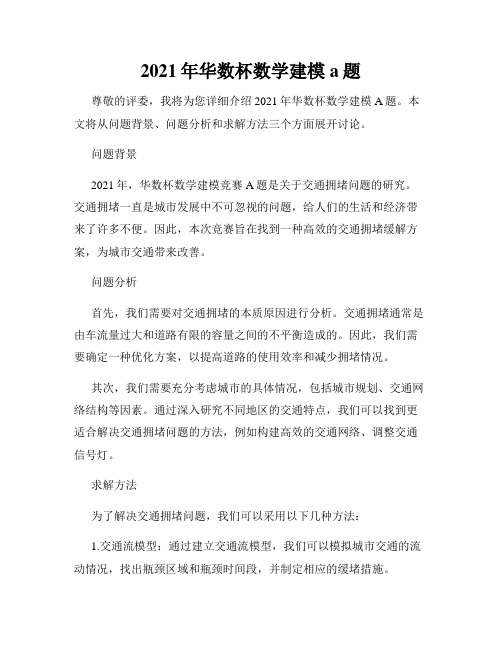
2021年华数杯数学建模a题尊敬的评委,我将为您详细介绍2021年华数杯数学建模A题。
本文将从问题背景、问题分析和求解方法三个方面展开讨论。
问题背景2021年,华数杯数学建模竞赛A题是关于交通拥堵问题的研究。
交通拥堵一直是城市发展中不可忽视的问题,给人们的生活和经济带来了许多不便。
因此,本次竞赛旨在找到一种高效的交通拥堵缓解方案,为城市交通带来改善。
问题分析首先,我们需要对交通拥堵的本质原因进行分析。
交通拥堵通常是由车流量过大和道路有限的容量之间的不平衡造成的。
因此,我们需要确定一种优化方案,以提高道路的使用效率和减少拥堵情况。
其次,我们需要充分考虑城市的具体情况,包括城市规划、交通网络结构等因素。
通过深入研究不同地区的交通特点,我们可以找到更适合解决交通拥堵问题的方法,例如构建高效的交通网络、调整交通信号灯。
求解方法为了解决交通拥堵问题,我们可以采用以下几种方法:1.交通流模型:通过建立交通流模型,我们可以模拟城市交通的流动情况,找出瓶颈区域和瓶颈时间段,并制定相应的缓堵措施。
2.优化算法:利用优化算法,我们可以确定最佳的交通信号灯配时方案,以最大程度地提高道路的通行能力和减少交通阻塞。
3.交通实时数据分析:通过实时监测和分析交通数据,我们可以及时了解交通拥堵的状况,并作出相应的调整措施,例如引导交通、改变路线等。
4.城市规划和交通网络优化:通过合理规划城市和交通网络,我们可以减少交通瓶颈区域的存在,提高道路的通行能力,从而缓解交通拥堵问题。
结论通过以上求解方法的综合运用,我们可以有效地缓解城市交通拥堵问题,提高交通效率和人们生活的便利性。
在未来的城市规划和交通发展中,我们应该更加注重交通拥堵问题的解决,以提升城市的发展水平和居民生活质量。
感谢您的耐心阅读,以上就是我对2021年华数杯数学建模A题的简要介绍和求解方法的论述。
希望这些解决方案能对您有所启发,谢谢!。
2024数学建模美赛c题思路
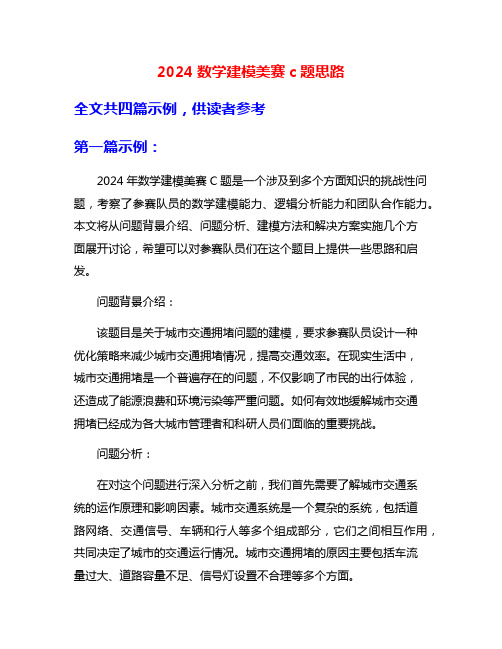
2024数学建模美赛c题思路全文共四篇示例,供读者参考第一篇示例:2024年数学建模美赛C题是一个涉及到多个方面知识的挑战性问题,考察了参赛队员的数学建模能力、逻辑分析能力和团队合作能力。
本文将从问题背景介绍、问题分析、建模方法和解决方案实施几个方面展开讨论,希望可以对参赛队员们在这个题目上提供一些思路和启发。
问题背景介绍:该题目是关于城市交通拥堵问题的建模,要求参赛队员设计一种优化策略来减少城市交通拥堵情况,提高交通效率。
在现实生活中,城市交通拥堵是一个普遍存在的问题,不仅影响了市民的出行体验,还造成了能源浪费和环境污染等严重问题。
如何有效地缓解城市交通拥堵已经成为各大城市管理者和科研人员们面临的重要挑战。
问题分析:在对这个问题进行深入分析之前,我们首先需要了解城市交通系统的运作原理和影响因素。
城市交通系统是一个复杂的系统,包括道路网络、交通信号、车辆和行人等多个组成部分,它们之间相互作用,共同决定了城市的交通运行情况。
城市交通拥堵的原因主要包括车流量过大、道路容量不足、信号灯设置不合理等多个方面。
建模方法:针对这个问题,我们可以采用系统动力学建模方法。
我们需要构建一个城市交通拥堵的系统动力学模型,包括车辆的流量、交通信号的控制、道路的容量等因素。
然后,我们可以通过数学方程来描述这个模型中各个变量之间的相互作用关系,利用计算机模拟的方法来模拟城市交通系统的运行情况,分析交通拥堵的产生机制和影响因素。
解决方案实施:基于上述模型,我们可以提出一些优化策略来缓解城市交通拥堵。
可以通过调整交通信号的设置来控制车辆的流量,合理规划道路网络来提高道路的容量,并通过实时监测交通情况来及时调整交通管制措施等。
我们还可以结合智能交通管理技术和大数据分析方法来提高交通管理的效率和精度,进一步优化城市交通系统的运行。
2024年数学建模美赛C题是一个需要综合运用数学建模、系统动力学和大数据分析等多种方法的综合性难题,要求参赛队员在有限的时间内分析问题、建立模型、提出解决方案,并最终通过实施来验证解决方案的有效性。
2021fast数学建模
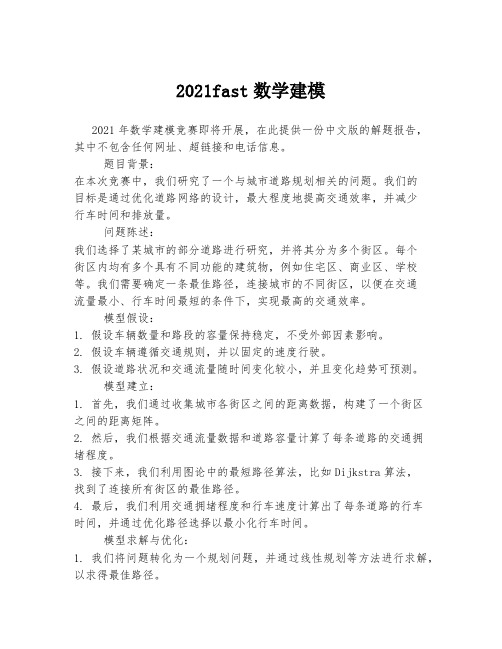
2021fast数学建模2021年数学建模竞赛即将开展,在此提供一份中文版的解题报告,其中不包含任何网址、超链接和电话信息。
题目背景:在本次竞赛中,我们研究了一个与城市道路规划相关的问题。
我们的目标是通过优化道路网络的设计,最大程度地提高交通效率,并减少行车时间和排放量。
问题陈述:我们选择了某城市的部分道路进行研究,并将其分为多个街区。
每个街区内均有多个具有不同功能的建筑物,例如住宅区、商业区、学校等。
我们需要确定一条最佳路径,连接城市的不同街区,以便在交通流量最小、行车时间最短的条件下,实现最高的交通效率。
模型假设:1. 假设车辆数量和路段的容量保持稳定,不受外部因素影响。
2. 假设车辆遵循交通规则,并以固定的速度行驶。
3. 假设道路状况和交通流量随时间变化较小,并且变化趋势可预测。
模型建立:1. 首先,我们通过收集城市各街区之间的距离数据,构建了一个街区之间的距离矩阵。
2. 然后,我们根据交通流量数据和道路容量计算了每条道路的交通拥堵程度。
3. 接下来,我们利用图论中的最短路径算法,比如Dijkstra算法,找到了连接所有街区的最佳路径。
4. 最后,我们利用交通拥堵程度和行车速度计算出了每条道路的行车时间,并通过优化路径选择以最小化行车时间。
模型求解与优化:1. 我们将问题转化为一个规划问题,并通过线性规划等方法进行求解,以求得最佳路径。
2. 根据实际情况,我们可对模型中的参数进行调整,以适应街区数量和车辆流量的变化。
3. 我们还可以通过引入交通信号灯等道路设施,进一步优化交通效率。
模型验证与评价:我们将通过实地调查和数据分析来验证模型的准确性和可行性。
通过与实际情况的对比,评估模型在提高交通效率方面的有效性和可行性,并根据实际效果对模型进行改进。
结论:通过优化道路网络设计和路径选择,我们可以在城市道路规划中提高交通效率,减少行车时间和排放量。
本模型为城市交通规划和道路设计提供了一个可行的参考方案,并为未来的研究提供了思路和方法。
数学建模交通量分析1

参考文献中网上资源的表述方式为:[编号] 作者,资源标题,网址,访问时间(年月日)。
[1] 上海日浦信息技术有限公司,青岛岛胶州湾隧道工程性能化防火分析,http://forum8.jp/fair/nepoch-conf2-review/EXODUS-2.pdf,2011年11月18日交通量分析人流量计算结果根据车辆和满客率的不同,拥堵车辆的人数也将不同。
按照PIARC数据推荐:大客车60座中客车12座小客车4座根据相关规范,在本报告中满客率取为1.0和0.666。
其拥堵时人流量计算结果参见下表消防性能化评估基础人员疏散安全标准模拟软件人员疏散安全标准著名的NFPA-130标准主要是针对轨道交通而提出的,其判定准则主要包括:(1)气体温度;(2)一氧化碳CO的浓度;(3)能见度;(4)热辐射量;软件的主要功能和结构本软件主要由三部分组成,包括情景设计系统,专家定义系统,CFD计算引擎。
各部分的主要功能分工参见图。
在建模结束后采用系统本身特有的智能化网格系统可以迅速形成CFD计算格式,经过代码优化的CFD引擎对于网格精度不再过度的依赖,这保证了制约CFD计算最重要的瓶颈-速度与精度,和同类型软件比较具有明显优势。
后处理系统可以对CO浓度、能见度、热辐射以及烟气温度根据断面和时间的不同,整理出蔓延曲线,这使得性能化评估工作更加直观。
火灾场景设计火灾规模分析火灾场景设计火灾规模分析在本报告模拟中主要考虑以下情形:(1)一辆公共汽车起火(20MW);(2)两辆公共汽车相撞(40MW)。
根据PIARC研究成果,本工程模拟火灾的烟雾产生主要是由庚烷燃烧产生的。
国内外通常采用稳态和非稳态2类模型来描述火灾的发展,其中以非稳态t2火模型为代表。
其采用如下方程对火灾进行描述:Q= αT2Q -火源热释放率,(KW);α-火灾增长系数,(kW/s2);T-火灾发展时间,(s)。
本工程中采用超快速增长模式:α =0.1878,326秒后达到峰值。
- 1、下载文档前请自行甄别文档内容的完整性,平台不提供额外的编辑、内容补充、找答案等附加服务。
- 2、"仅部分预览"的文档,不可在线预览部分如存在完整性等问题,可反馈申请退款(可完整预览的文档不适用该条件!)。
- 3、如文档侵犯您的权益,请联系客服反馈,我们会尽快为您处理(人工客服工作时间:9:00-18:30)。
RELATIONSHIP BETWEEN CONGESTION AND TRAFFIC ACCIDENTS ON EXPRESSWAYS AN INVESTIGATION WITH BAYESIAN BELIEF NETWORKSBy Charitha Dias**, Marc Miska***, Masao Kuwahara****, and Hiroshi Warita*****1. IntroductionAccidents and congestion are two frustrating events, which can be observed very frequently on roads. Accidents, especially on expressways, can trigger heavy traffic congestions imposing huge external costs and reducing the level of service. Therefore it is obvious that accidents clearly have an impact on congestion. But the opposite, i.e. the effect of congestion on occurrence of accidents, is less studied and still questionable 11). One can argue that congestion can reduce the high speeds on expressways and as a result of that the accident rate is reduced. But in a congested road section vehicles are closely packed and as a result of that rear-end collisions, back-up collisions as well as side collisions can occur. Therefore it is important to analyze the impact on the accidents by congestion so that the policy makers can implement relevant measures to reduce the external costs of both accidents and congestion.This paper investigates the effects of traffic congestion on the occurrence of accidents on 8 radial routes (inbound direction) of Metropolitan Expressway (MEX). Data were obtained from the International Traffic Database (ITDb) 6). Two softwares, namely WinMine Toolkit 2) and MSBNx 5), which use the concept of Bayesian Belief Networks (BBN), were used to model the interrelationships among occurrence of accidents and other variables such as congestion index (CI), traffic density and volume.2. Relationship between congestion and accidentsVery limited attempts have been made, in the past by several authors, to describe the relationship between accidents and congestion. Among those, Wang et al.11) claimed that traffic congestion, controlling other factors such as flow, curvature, gradient, section length, no. of lanes etc., has little or no impact on frequency of accidents (fatal or non-fatal), using data for M25 highway. But the CI values in their data were relatively low, i.e. less than 0.5, for most of the cases. Therefore, it is questionable that those data really represented congested situations.Noland and Quddus8) used a series of negative binomial models to analyze the effect of congestion on road safety. Their results were not conclusive, suggesting that there is little effect of congestion on road safety. They suspected that this might be due to the weakness of proxies they used to represent congestion, plus might be due to the method they implemented to model relationships. While above mentioned studies claimed that there is no any significant relationship between accidents and congestion, Golob and Recker 4), using nonlinear multivariate statistical analysis, concluded that rear-end collisions are more likely to occur under heavily congested stop-and-go traffic. Though this is an indication that congestion has an effect on accidents, the* Keywords: traffic accidents, congestion, Bayesian belief networks** Non-member of JSCE, M. Sc., Chodai Co., Ltd.(2-1-3 Higashi-Tabata, Kita-Ku, Tokyo, Japan 114-0013, Tel: +81-3-3894-3236, Fax: +81-3-3894-3265) *** Member of JSCE, Lecturer, Institute of Industrial Science, University of Tokyo(4-6-1 Komaba, Meguro-ku, Tokyo, Japan 153-8505, Tel: +81-3-5452-6419, Fax: +81-3-5452-6420)**** Member of JSCE, Professor, Institute of Industrial Science, University of Tokyo(4-6-1 Komaba, Meguro-ku, Tokyo, Japan 153-8505, Tel: +81-3-5452-6419, Fax: +81-3-5452-6420)***** Member of JSCE, Planning and Environment Department, Metropolitan Expressway Co., Ltd.(1-4-1 Kasumigaseki, Chiyoda-ku, Tokyo, Japan 100-8930, Tel: +81-3-3539-9389, Fax: +81-3-3502-2412)link between accidents and congestion has not elaborated clearly.Though some other authors have attempted to explore the relationship between accidents and traffic volume or flow 1)3), these studies may not describe the relationship between accidents and congestion, because according to speed-flow characteristics not only flow but also speeds are also needed to determine whether the prevailing traffic condition is congested or un-congested.These limited previous studies suggest us the need for more studies to better understand the impact of congestion on accidents. In this study BBNs, which can model and graphically interpret the relationships in any system, were used to model the interrelationships among CI, volume, density and occurrence of accidents.3. Methodology(1) Data descriptionFive-minutes aggregated volume, average speed, occupancy and incident data on inbound direction of 8 radial routes (Route numbers 1, 2, 3, 4, 5, 6, 7 and 9) of the MEX, collected over one week were used. One-week data (from 5th June 2006 to 11th June 2006) of ITDb on MEX is free for public and that free data was used for this analysis. Format of raw data is shown in Figure 2.(2) Data arrangementa) Pre-accident period.First the other incidents such as car breakdowns, road works etc. were removed and the 15 minutes time period before an accident was defined as pre-accident period (Figure 2). Here, 15 minutes was selected just to represent the average traffic conditions on the road section before an accident. b) Congestion Index (CI)Congestion index expresses the congestion level of a given road section relative to the free-flow conditions. It is non-negative and dimensionless value. Average speed data was converted in to congestion data, i.e. congestion indexes (CI), with slightly modified version of Taylor’s 9) method, as follows.{tionroad the for speed flow Free tionroad the for speed Average Where ifand if CI VV VV V VV V V V FFFFFF FFFFFF sec sec ;;0;/)(−−>>≤−=Figure 1: Metropolitan expressway (MEX)networkc) V olume classes, CI classes and density classes V olumes, CI’s and occupancies were categorized in to classes as shown in Table 1. This was done because categorized data were needed to learn BBNs.Table 1: Categorized volumes, CIs and densitiesFigure 2: Available data(3) Bayesian belief Networks (BBN)BBNs are probabilistic graphical models that represent a set of variables and their conditional independencies via a directed acyclic graph 12). BBN is an effective technique to understand the relationships among variables because BBNs can model the interrelationships among variables with their conditional probabilities in any kind of a system and represent them graphically.Two applications namely WinMine Toolkit2) and MSBNx5), which use the BBN concept, were used to identify conditional independencies among variables and to perform inference, respectively. WinMine toolkit is set of tools, designed for Windows environment, that allow constructing statistical models from categorized data. WinMine has many advantages compared with other traditional methods such as bar graphs, contingency tables and odd ratios to mine for information in data because it can provide a better picture of the factor interrelationships among variables 7). MSBNx is a component-based application, which can be used to create, assess and evaluate Bayesian networks 5). It is an excellent tool for inference or updating probabilities. Categorized volume, CI, density and event for each route were fed in to WinMine toolkit separately in order to obtain the dependency network, which is very similar to Bayesian network. For inference purposes the conditional probabilities, determined with WinMine, were fed in to MSBNx. Figure 3 depicts dependency network along with the conditional probability table (CPT) for the node “Event”, constructed with WinMine, and Figure 4 depicts the BBN with un-conditional probability tables for all nodes, constructed with MSBNx, for the inbound direction of Route 4 of MEX.At a glance some important information can be drawn from these figures. Figure 3 describes the dependencies among the variables in data fed in to WinMine. Figure 4 shows how the inbound direction of Route 8 functions. 15% of the time, within the considered one week time period, it is congested or heavily congested, 76% of the time medium volumes and 81% of the times low densities could be observed. And there is around 1% of chance of an accident.Figure 3: Dependency network constructed with WinMineFigure 4: BBN constructed with MSBNxUn-conditional probabilities, which are shown in Figure 4, are probabilities before any evidence is observed and those are called prior probabilities. When evidence is observed, for example when it is known that the CI reflects heavily congested situation, probabilities for all other nodes can be updated and those updated probabilities are called posterior probabilities. And this process of updating probabilities is called inference. Inference was performed for BBNs for each considered routes with MSBNx and updated probabilities were noted. Results are described in Section 4.4. ResultsProbabilities of occurring a pre-accident period were plotted against congestion levels, as in Figure 5, and probability of occurring a pre-accident period was plotted against density levels, as in Figure 6. Figure 5clearly shows that the chance of an accident is increasedwith the congestion level.High density reflects high congestion levels. When occurrence of accidents is increased with the increase of density levels, as shown in Figure 6, it reflects that probability of accident occurrence is increased with congestion levels. Therefore both Figure 5 and Figure 6 describe that the accident occurrence is increased with congestion levels.Table 2 compares the congestion levels and density levels when a pre-accident condition is evidenced and non-pre-accident condition is evidenced.When a pre-accident situation is evidenced, the probability that the road section is in congested conditions is in the range of [60%, 87%]. And compared to that, when none (a non-pre-accident condition or any other incident) is observed the probability that the road section is congested is pretty low, i.e. in the range of [8%, 20%]. This reflects that when an accident occurred most of the time road section was congested.These results probably describe the drivers’ behavior at congested situations. On congested roads, where stop-and-go conditions are prevailed, frustrated drivers try to accelerate resulting rear-end collisions. And some drivers may try to change their lanes resulting side collisions plus back-up collisions. However, it should be kept in mind that fatalities are less in congested road sections compare to un-congested sections where operating speeds are high 10).Figure 5: Probability of observing a pre-accidentcondition given the congestion level5. Summary(1) ConclusionsFigure 6: Probability of observing a pre-accidentcondition given the density levelFlow, speed, occupancy and event data on inbound direction of 8 radial routes of MEX, collected over one week period, were used to explore the impact of congestion on occurrence of accidents. BBNs were used to model the relationships among pre-accident conditions and other variables. It was found that when a road section is getting congested, i.e. when the CI is increased and density is increased, the chance for an accident could be increased. Analysis of accident types will more clearly provide the answer for why probability of accident occurrence increases with congestion level.(2) Further researchThese results may not totally describe the mechanism of occurrence of accidents and congestion on MEX. Broad analysis is needed, which considers all factors that may cause accidents and congestion such as weather, road geometry, driver characteristics etc., to get a betterTable 2: Conditional probabilities of CI and density ifpre-accident condition is observedpicture of pre-accident conditions.Although the probability of occurring a pre-accident situation is increased with the increase of congestion, accidents occur under congested situations are not fatal compared to accidents occur under high-speed situations. Here in this analysis, severity of accidents and types of accidents were not considered due to lack of data. Therefore, it is interesting to extend the analysis to consider the severity levels as well as types of accidents, too.6. AcknowledgementAll traffic measurement data for this study was provided by the International Traffic Database (ITDb). Data available to the public can be accessed through .References1) Ceder, A.: Relationships between road accidents and hourly traffic flow. II. Probabilistic approach, Accident Analysis and Prevention, 14 (1), pp.35–44, 1982.2) Chickering, D.: The WinMine Toolkit. Redmond, WA., Microsoft technical report no. MSR-TR- 2002-103, 2002.3) Dickerson, A., Peirson, J., Vickerman, R.: Road accidents and traffic flows: An econometric investigation, Economica, London School of Economics and Political Science, V ol. 67(265), pp. 101-21, 2000.4) Golob, T. F. and Recker, W. W.: Relationships Among Urban Freeway Accidents, Traffic Flow, Weather and Lighting Conditions, Institute of Transportation Studies, University of California, Berkeley, 2001.5) Kadie, C. M., Hovel, D., and Horvitz, H.: MSBNx: A Component-Centric Toolkit for Modeling and Inference with Bayesian Networks, Microsoft Research Technical Report MSR-TR-2001-67, 2001.6) Miska, M., et al.: The International Traffic Database Project, 14th World congress on intelligent transport systems, CD-ROM, 2007.7) Milburn, N. J. et al: Mining for information in accident data, Final report, Federal aviation administration, Civil Aerospace medical institute, Oklahoma city, 2006.8) Noland, R.B., Quddus, M.A.: Congestion and safety: a spatial analysis of London, Transportation Research Part A: Policy and Practice 39 (7-9), pp. 737-754, 2005.9) Taylor, M.A.P., Woolley, J.E., Zito, R.: Integration of the global positioning system and geographical information systems for traffic congestion studies. Transportation Research Part C: Emerging Technologies 8 (1-6), pp.257-285. 2000.10) Taylor, M. C.: The speeds of vehicles which are involved in fatal accidents, Traffic Engineering and Control 42(2), 2001.11) Wang, C., Quddus, M. A., Ison, S. G.: Impact of traffic congestion on road accidents: A spatial analysis of theM25motorway in England, Accident Analysis and Prevention, 2009.12) Wikipedia contributors: Bayesian network, Wikipedia, The Free Encyclopedia, /w/index.php?title=Bayesian_network&oldid=293220919 (accessed May 30, 2009).。
